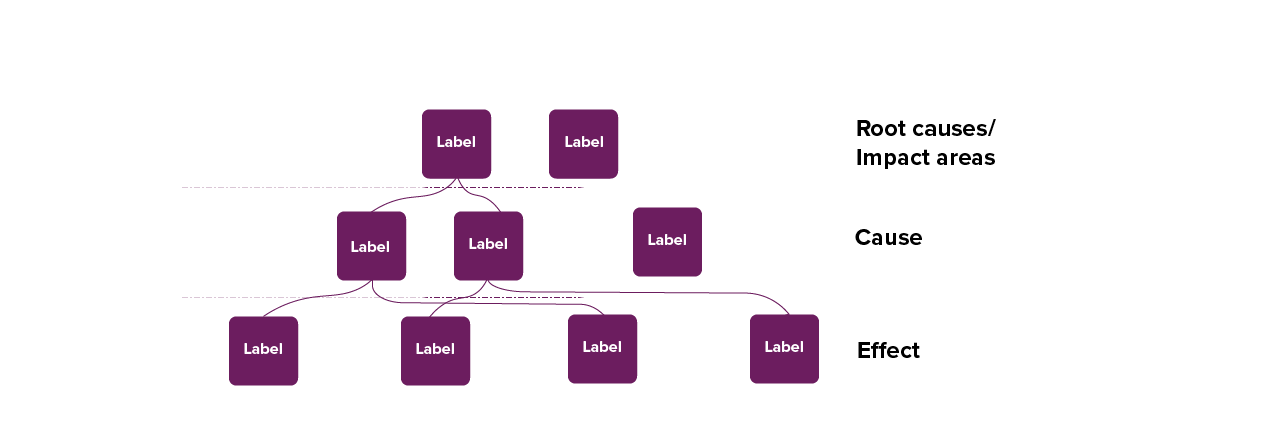Do you know that feeling when you walk to your car and something feels off, but you don’t know what? Then when you try to open your car, arghh, you notice you forgot to take your car keys with you. This is of course an example of a simple situation with a straightforward solution.
Now imagine, that you are a leader in an organization. You walk around the office, and something feels off. Two years ago, you started a new way of working, departments transformed, and everything improved... Or did it? Still, you see a lot of teams struggle with deadlines, still you see collaboration issues and still, you see a lot of decisions made on gut feeling instead of data.
This situation is much more complicated or even complex, after all, we are dealing with a complex social system here, not a car lock. What’s causing these issues, why are they still occurring even after two years of the change effort and how could we possibly fix them?
This article shows what you could do to get to the root cause(s) of the challenges and create a holistic starting point in the form of a map that you could use to navigate toward solutions.
Get to understand the challenge better, start by connecting
If you want to understand more of the challenges in the organization, start talking to the people that have to deal with them daily. That’s right, understanding starts with empathy and connecting to others. 99% of your organization is the people and their interactions, so this is a good starting point for your journey.
Who to talk to?
Talking to people means you are taking a qualitative approach to investigate the situation further. Now you must decide on who to talk to. This is not as difficult as it seems. If you have teams delivering a certain feature and they need to collaborate, make sure you talk to a cross-section of all roles involved in the delivery.
Role distribution is something to consider, for instance, the number of people with an engineering role versus managers. If there are 10 engineers involved and two managers, maybe you could think about talking to 3 engineers and 1 of the managers. This is important because you want to obtain a full and representative view within the time you have.
You do not have to talk to everybody involved, as at a certain point you will get to hear people mentioning the same kind of things. This is what you are looking for, patterns and red threads.
Example:
| Role |
# of people with role |
# to interview |
| Developer |
10 |
4 |
| Testers |
4 |
2 |
| UX |
2 |
1 |
| Scrum masters |
2 |
1 |
| Product owner |
1 |
1 |
Table 1: Example of role distribution and interview selection
What to talk about?
A good way to approach the talk itself is to structure it around 3 key points; sense of urgency, ability to improve, and willingness to improve. All three are necessary ingredients for effective change, but also provide excellent exploratory perspectives for the talk.
For instance, you could use this as an opening question; “what urgent matters do you feel we should address when we collaborate on delivering features?” From here people might mention all sorts of issues and challenges to further explore using follow up questions. Stay inquisitive and use open questions for further exploration.
At the end of the talk, ask people to rate the 3 key points from 0 to 10, for instance ‘0’ meaning “this topic is not urgent at all”, to ‘10’ meaning this is a burning platform. When you collect all these scores insights and put the averages in a graph insight appears on the ‘change readiness’ for the challenges at hand.

Figure 1: change readiness score graph
Change readiness can be influenced by all 3 key points, or a combination thereof. For example;
Low urgency scores:
People do see a sense of urgency, but it’s not as important as other challenges or directives, or people don’t understand or even experience a sense of urgency. If you would try to change the issue now, first get across the urgency to start moving on the challenge and place it in perspective of other things that might be happening. Otherwise, this topic will surely be misunderstood, de-prioritized or ignored by people having to do something about it.
Low ability scores:
People might find the challenge urgent and are willing to do something about it, but for some reason they can’t. There might be something blocking them, and it might be as simple as the inability to make time for improvement. Other reasons might be missing capabilities, knowledge, or tooling. It’s good to now, because changing with low ability scores will cause frustration as people are inhibited to act.
Low willingness scores:
There might be low willingness to change. This is probably the trickiest one, as it is more subjective and opinionated. Maybe the delivery pressure is too high to spend time on figuring out how to improve, or maybe people just don’t acknowledge the issues and find this to be someone else’s responsibility. Whatever the reason, a low score on willingness might mean having to convince people to do something.
How to process answers and results
During your talk, you need to take notes of what people say and write down quotes that capture and illustrate the points people make. After the interviews you will have a lot of interview results and insights gathered on urgency, ability and willingness.
A good process to make all results more manageable for yourself is to use induction and summarize results per key point to next ‘label’ these summaries to express an overarching theme

Figure 2: induction of results to labels
How to find out what’s really going on
Some of the things people say in the interviews will be effects of things happening, for instance; “our sprint goals change during the sprint” this is because managers don’t take the product owner role too seriously and overrule them if something need to happen according to them.
Here you can see people mentioning an effect and additionally behavior causing the effect. Maybe more things will be said on shifting goals, unclarity or parallel agendas. This could get the label of “lack of focus”. The behavioral part might be labeled as “inconsistent understanding of way of working”. All the labels you discover need to be placed in cause effect relationships, where in the end, you can also discover impact areas or root causes of the issues you are trying to uncover.

figure 3: cause-effect map to challenges
Moving from a mapped insight to solutions
Once your map is clear you could validate it by talking it over with the people that you interviewed. This is important as they are probably also involved in solving the challenges and therefor need buy-in for their efforts.
Once validated it’s time to start work towards solutions and solving challenges. There are various ways to decide on where to start, but rule of thumb is to not spend time on the ‘effect lane’ of your map, and if you determined root causes, get close to those.
Asking for help
Congratulations! You got to the bottom of things and fully understand what’s going on…or do you?
Maybe it’s good to ask why you didn’t know about things in the first place. Do your people tell you what’s going on, still come to you for help, and tell the honest story? Do you facilitate this yourself and do you provide enough trust and safety to share things in full transparency?
Sometimes it’s good to request some expert neutral help on these kinds of matters. After all, you yourself as a leader are part of the system, the dynamics of that system, and its culture.
At Xebia, we are experts in finding out what’s going on, even after transformation. We use the described steps in this article to create transparency for organizations in what they can do to fix their challenges and grow to their next level!





